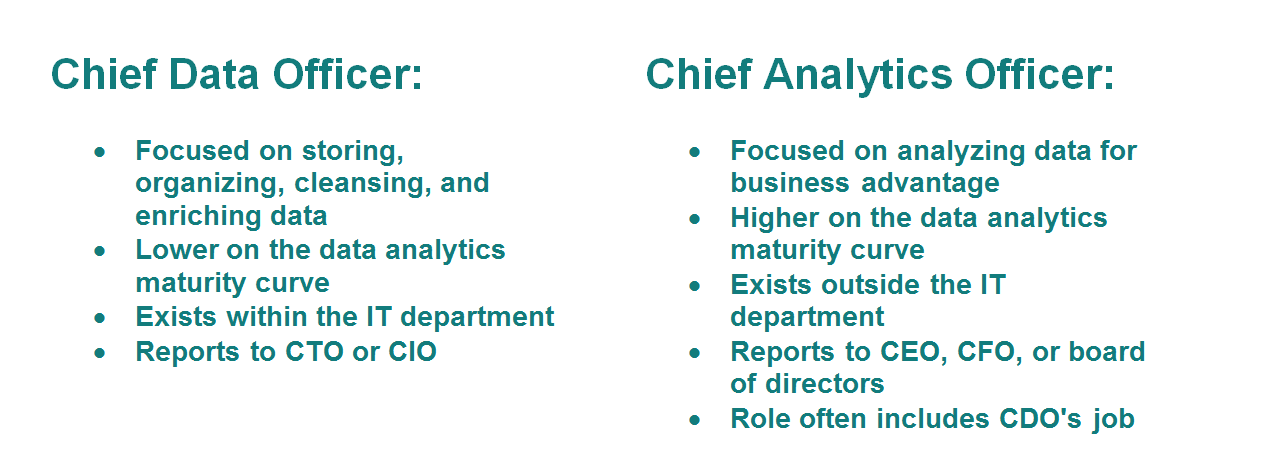
CAO or CDO? Analytic Institute Examines Differences

One of the most important challenges a company faces as it embark on a big data journey is hiring the right people for the right roles. But quite often, companies are faced a dilemma: Should they hire a chief data officer (CDO) or a chief analytic officer (CAO)? During a one-day summit next month, the International Institute for Analytics will give you clues to the answer.
There are many difference between CDOs and CAOs, but the most important one involves the primary focus of each role, says Jack Phillips, the CEO and co-founder of the International Institute for Analytics (IIA), which is hosting the Chief Analytic Officer Summit (CAOS) on October 27 at the Bellagio in Las Vegas.
“The first distinction is a maturity level,” Phillips says. “If you’re early on [in the analytics journey] and you have traditionally had very siloed data and not a particular focus on data organization, then obviously somebody whose job is purely to integrate, clean, organize, prepare, and think about data as an asset for the institution is probably pretty relevant.” This role describes a CDO.
“When you as a firm turn the corner and say ‘What are the great things we can do with the data on the analytical side,’ what we see then is a maturing up to a CAO, which often incorporates the data side as well.”
Quite often, just getting a handle on data is the first step that companies take on their big data journey. The natural state of data management in the enterprise is not a pretty sight, with different departments hoarding data and disagreeing on standards and metrics. Only after a CDO (or somebody with a different title who’s tasked with similar responsibilities) makes the effort to ensure that the data is well organized can meaningful analytics take place.
“Clearly, to perform good analytics, you have to have strong, organized, high-quality data,” Phillips tells Datanami in an exclusive interview. “But really, that unto itself isn’t that interesting. It’s when you begin to apply analytical and quantitative methods to the data that things become really interesting. We see increasingly that that’s the Promised Land. It is a divided role in some cases. But ultimately our recommendation to the world is a CAO would oversee all that.”
Reporting Structures
Differentiating the CDO and the CAO roles will be a primary topic at the upcoming CAOS show. The company, which Phillips and Research Director Thomas H. Davenport founded in 2010, provides unbiased advice to high-level executives who are practicing data analytics in large enterprises.
Another important distinction is reporting structure. CDOs will typically exist within the IT department, and possibly report to the CTO or the CIO, while the CAO often takes his queues from the CEO, the CFO, or the board of directors.
“The CAO and the analytic team should not be in IT,” Phillips asserts. “The CTO or CIO have traditionally put data management under their responsibility. It usually takes some senior level thinker, either the CFO or CEO or the board, saying something along the lines of ‘It’s time to think of our data as a strategic asset.'”
 The first step in treating data as a strategic asset is often to assign a CDO. Phillips draws a comparison between the emergence of the CDO and the emergence of the chief information security officer (CISO). When companies realized that cyber security was something that needed to be centrally managed instead of operating in separate silos, they put that responsibility into the hands of the CISO. A similar pattern happened with data.
The first step in treating data as a strategic asset is often to assign a CDO. Phillips draws a comparison between the emergence of the CDO and the emergence of the chief information security officer (CISO). When companies realized that cyber security was something that needed to be centrally managed instead of operating in separate silos, they put that responsibility into the hands of the CISO. A similar pattern happened with data.
While CDOs concern themselves with the health of data across the enterprise, the CAO is responsible for managing the algorithms and various quantitative methods that enterprises want to use. In this manner, CAOs typically serve multiple business units within the enterprise, such as marketing, human resources, sales, supply chain, or customer service
“When you get to an analytical level that calls for a CAO, that usually signifies that the firm has gone through three to four stages of maturity and you’re to a point where some senior leader say ‘Let’s be international and not reactive around the analytics and data,'” Phillips says.
The game plans are considerably different among the various roles. “The CAO is playing offense, whereas the CISO was largely playing defense and trying to make sure the company stays out of trouble,” Phillips says. “The CAO is trying to gain share and grow the business through this really interesting set of tools that really can differentiate you from the competition.”
Growth of CAOs
A recent Teradata report found about 11 percent of companies had somebody with the CAO title on staff. That sounds about right to Phillips if you count people with that exact title. But the percentage of companies who have somebody doing the work of a CAO (but who may have the title of VP or manager of analytics) is probably closer to 25 to 30 percent, he says.
The number of firms with CAOs is definitely trending up, says Phillips, who adds that the title first started appearing about 36 months ago. However, some of those early CAOs appeared in vendor comaines who were trying to appear “in vogue,” Phillips says. The emergence of CAOs in mainstream end-user companies really stated to pick up steam about 24 months ago.
The CDO role is more commonplace in American corporations. According to a 2014 study, 50 percent of Fortune 500 companies were predicted to have a CDO by 2015.
While Phillips says a CAO will typically take over the duties of the CDO, there are cases where companies will maintain separate CAO and CDO. “There is no consistent answer yet,” he says. “I think everybody is trying to figure it out.”
The CAO is also responsible for calculating the return on investment (ROI) on big data analytics, which can be difficult to calculate. “They are the steward of that ROI math,” Phillips says. “The highest performing CAO out there is very adept in value calculation. He’s very keen to really understand that intimately.”
The CAO must compete with other department heads for funding for analytics projects, so he must understand how investments in other areas of the business will pan out. “If the CAO is too focused on things like technology and data and not on how does this improve the business, they may not last long,” Phillips says.
Whereas the CDO will be in charge of enforcing data hygiene, the CAO is responsible for fostering an analytic culture at his company. “The CAO is really the ombudsman, the head of culture change toward data-driven decision-making broadly,” Phillips says. “It absolutely takes an effort not just to have good data and a model, but enabling business users to adequately use the results to make better decisions.”
The CAOS summit is an invitation-only event, and there is still space available. If you are interested in applying for an invitation, you can contact the company at www.caosummit.com.
Related Items:
Five Ways CDOs Turn Data into Dollars




























